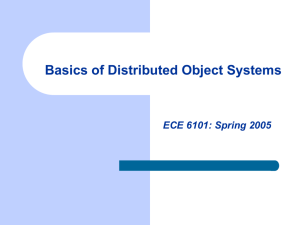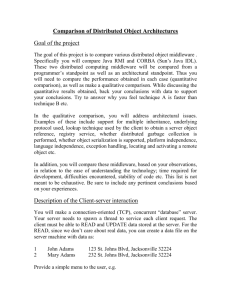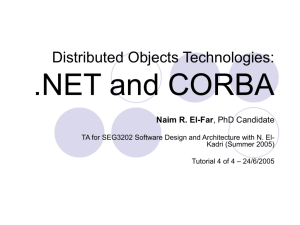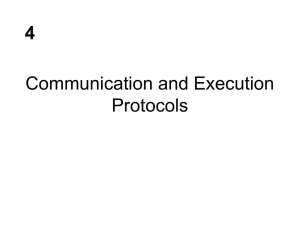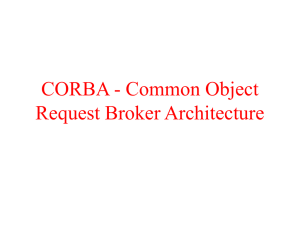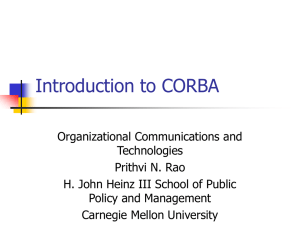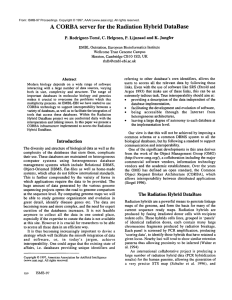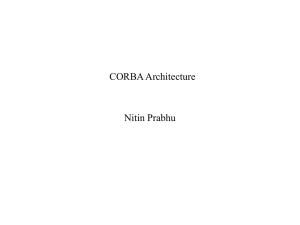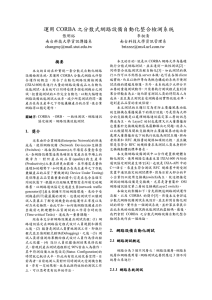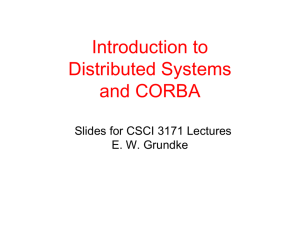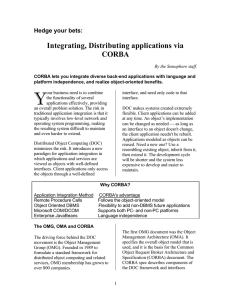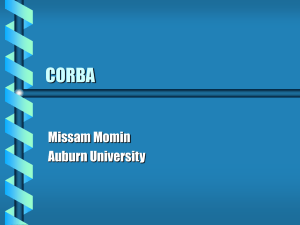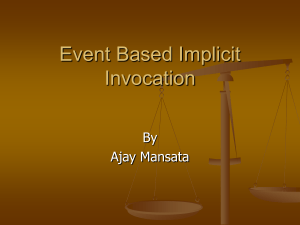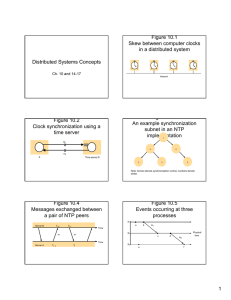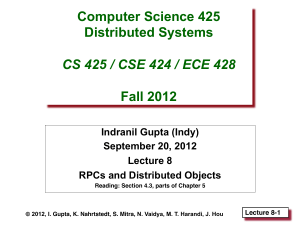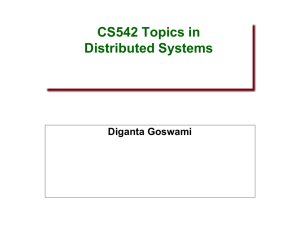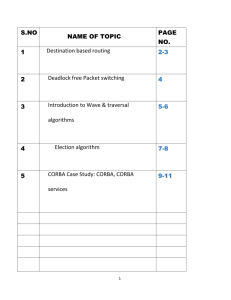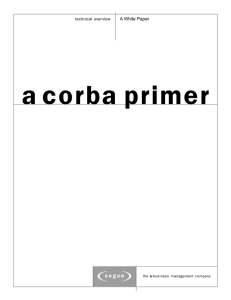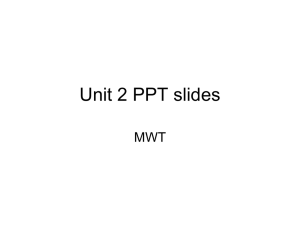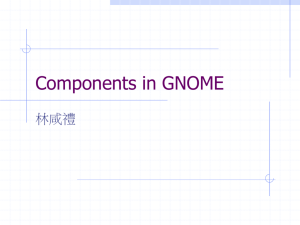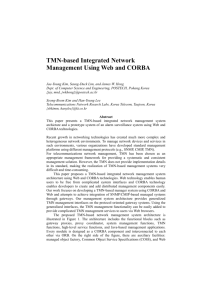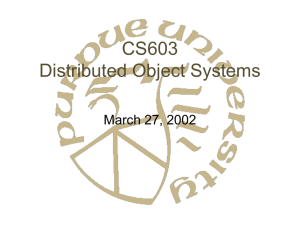Distributed Objects - ECE
advertisement
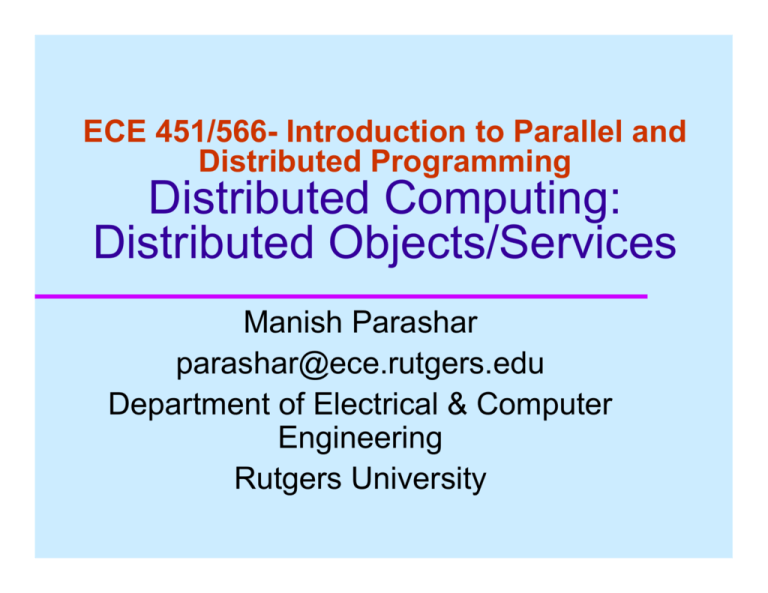
ECE 451/566- Introduction to Parallel and
Distributed Programming
Distributed Computing:
Distributed Objects/Services
Manish Parashar
parashar@ece.rutgers.edu
Department of Electrical & Computer
Engineering
Rutgers University
Distributed Object Computing
Enable
any “agent” in the local system to
directly interact with an object that resides on
a remote host.
– CORBA
– RMI (Java)
Distributed Objects versus Message Passing
– Simplicity
– Robustness
– Manageability
– Extensibility
2
Distributed Objects: Goals
Let
any object reside anywhere in the
network, and allow an application to interact
with these objects exactly in the same way as
they do with a local objects
Provide the ability to construct an object on
one host and transmit it to another host
Enable an agent on one host to create a new
object on another host.
3
Remote and local method
invocations
local
remote
invocation
A
B
C
E
invocation local
invocation
local
invocation
D
remote
invocation
F
4
A remote object and its remote
interface
remoteobject
remote
interface
{
Data
m1
m2
m3
implementation
of methods
m4
m5
m6
5
Distributed Objects: Issues
Creating
remote objects
Remote method calls
– get class reference
– call constructor with arguments
– get reference to new object
– get method reference
– call method with arguments
6
Distributed Objects: Issues
Data
marshalling
Arguments by value/by reference
Consistency across multiple clients/servers
Balancing work-load
7
Middleware layers
Applications
RMI, RPC and events
Request reply protocol
Middleware
layers
External data representation
Operating System
8
Middleware: Transparency
Location
Communication
protocol
Computer hardware
Operating system
Programming language
…
9
Object Interface Specification
Platform/language
independent means for
specifying object interfaces
Compiled to server skeletons and client stubs
– Interface definition language (IDL)
– Inter-language Unification (LU)
– Component Object Model Language (COM)
10
Example – Interface Definition
// In file Person.idl
struct Person {
string name;
string place;
long year;
};
interface PersonList {
readonly attribute string listname;
void addPerson(in Person p) ;
void getPerson(in string name, out Person p);
long number();
};
11
Object Manager
Heart of the distributed object system
– manage object skeletons and object references on the
object server
» CORBA ORB, RMI Registry
– on remote object creation request
» locate skeleton, create new object, store new object, return
reference
– on remote method call
» route request to object, return result
– on remote object destruction request
» remove object from store
12
Object Manager
Special
services
– dynamic object activation
» invoke active/deactivate methods provided by the
object based on remote request
– object persistence
» store and restore object state
Object
manager may reside on server, both
client and server, or on a separate host
13
Registration/Naming Service
Acts
as an intermediary between object client
and manager
– object interface is registered with the service
– client queries service by name/type/…
– naming service routes request to the
appropriate object server
– service can also be used for routing method
invocations
14
Other Issues
Object
Communication Protocol
Development Tools
Security
15
The role of proxy and skeleton in
remote method invocation
server
client
object A proxy for B
Request
skeleton
& dispatcher
for B’s class
remote
object B
Reply
Communication
Remote
reference module
module
Communication Remote reference
module
module
16
Role of client and server stub
procedures in RPC
client process
server process
Request
client stub
procedure
client
program
Communication
module
Reply
server stub
procedure
Communication
dispatcher
module
service
procedure
17
CORBA
Common
Object Request Broker Architecture
– Developed by OMG (Object Management
Group) (1989, 1991)
– Generic framework for developing distributed
object systems
– Platform independent/language independent
18
CORBA
Object
Request Broker (ORB)
– enable clients and server objects to interact
– provide servers
» naming services, security services, …
Interface
Definition Language (IDL)
Dynamic Invocation Interface
Internet Inter-Orb Protocol (IIOP)
19
CORBA Architecture
CORBA overall architecture
20
CORBA components
Client
Idl stubs
Interface definition language
Dynamic invocation interface
Static Idl skeletons
dynamic skeletons
Interface repository
Object request broker
21
Some CORBA services(i)
Life-cycle
service
Persistence service
Event service
Naming service
Concurrency control service
Relationship service
22
Some CORBA services(ii)
Externalisation
service
Query
service
Licensing service
Properties service
Time service
Security service
Trader service
23
An example of the CORBA Idl
module Tester{
interface Single{
attribute string exname;
readonly attribute string location;
string returnsVals(in string point);
}
}
24
A CORBA application
Client code
Server code
Skeleton code
Stub code
ORB
Transport mechanism
25
Developing a CORBA application
Write
the IDL descriptions
Process IDL
Develop the remote object classes
Develop server code
Develop client code
Deploy
26
The main components of the
CORBA architecture
client
client proxy ORB
program for A core
or dynamic invocation
implementation
repository
Request
Reply
server
interface
repository
object skeleton
adapter
ORB
core
Servant
A
or dynamic skeleton
27
Java RMI
Remote
Object Interfaces
Server Implementations
RMI Registry
Client Stubs and Server Skeleton
Serializing Objects
28
RMI V/s CORBA
Language
barrier
Virtual Machine
Efficiency
Elegance
Ease-of-use
Communication model
Support
29
